EPA ruling on emissions coming out soon: The U.S. Environmental Protection Agency will be releasing its final ruling on the fuel economy and emissions standards this week, as the deadline approaches Sunday, April 1. EPA Administrator Scott Pruitt is expected to announce a cut in the standards and issue a 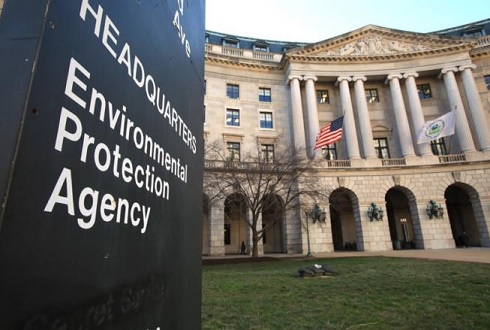 new rule-making timeline. The new standards could be released as early as this summer. Bloomberg and Reuters, citing anonymous sources, reported on Friday that the second round of rule, covering 2022-2025, will be relaxed. Automakers had asked the Trump administration to stick to the original April 1 deadline, and to block the Obama administration’s late decision to accelerate and end the review. The National Highway Traffic Safety Administration has differing concerns than the EPA under the Obama administration. Margo Oge, the former EPA official who helped develop the fuel economy and emissions standards, said she is worried that NHTSA is preparing to “gut the 2025 program.” Her concerns have been raised by reports in Bloomberg that NHTSA was considering options such as dropping fleetwide fuel economy to 35.7 mpg by 2026, down from the 46.6 mpg target set under the Obama administration.
new rule-making timeline. The new standards could be released as early as this summer. Bloomberg and Reuters, citing anonymous sources, reported on Friday that the second round of rule, covering 2022-2025, will be relaxed. Automakers had asked the Trump administration to stick to the original April 1 deadline, and to block the Obama administration’s late decision to accelerate and end the review. The National Highway Traffic Safety Administration has differing concerns than the EPA under the Obama administration. Margo Oge, the former EPA official who helped develop the fuel economy and emissions standards, said she is worried that NHTSA is preparing to “gut the 2025 program.” Her concerns have been raised by reports in Bloomberg that NHTSA was considering options such as dropping fleetwide fuel economy to 35.7 mpg by 2026, down from the 46.6 mpg target set under the Obama administration.
Nissan wants to maintain EV lead: Nissan wants to maintain its market leader position in electric vehicle sales gained through the Nissan Leaf by launching eight new EVs and hitting a one million annual EV sales target by 2022. The new strategy will also mean bringing out 20 new models with autonomous driving technology to 20 markets by that time. All of its Nissan and Infiniti models will have 100% connectivity by that time, the company said. The Japanese automaker plans to increase global annual revenue during that time to 16.5 trillion yen ($160.0 billion), from the 12.8 trillion yen ($120.0 billion) announced in the fiscal year that ended last month. That will come through a sustained 8% operating profit margin, Nissan executives said at a briefing on Friday at Nissan’s global headquarters in Yokohama, Japan.
Mack Trucks finding fuel savings at ports: Volvo Group’s Mack Trucks will be using “geofencing” technology to switch over a plug-in hybrid truck between  electricity and diesel in a pilot program. Mack trucks is testing out an automated GPS-based system that can switch between multiple modes of operation to reduce diesel consumption and air pollution. The geofencing utilizes GOA and radio-frequency identification technology at the ports of Los Angeles and Long Beach, which has been able to increase fuel savings in the 25-to-30 percent range. The ports have become a hub for alternative fuel testing; that includes a Cummins Westport project testing low NOx natural gas engines, Toyota testing a fuel cell electric drayage truck, and a few battery-electric BYD drayage trucks moving freight from the ports to area warehouses.
electricity and diesel in a pilot program. Mack trucks is testing out an automated GPS-based system that can switch between multiple modes of operation to reduce diesel consumption and air pollution. The geofencing utilizes GOA and radio-frequency identification technology at the ports of Los Angeles and Long Beach, which has been able to increase fuel savings in the 25-to-30 percent range. The ports have become a hub for alternative fuel testing; that includes a Cummins Westport project testing low NOx natural gas engines, Toyota testing a fuel cell electric drayage truck, and a few battery-electric BYD drayage trucks moving freight from the ports to area warehouses.

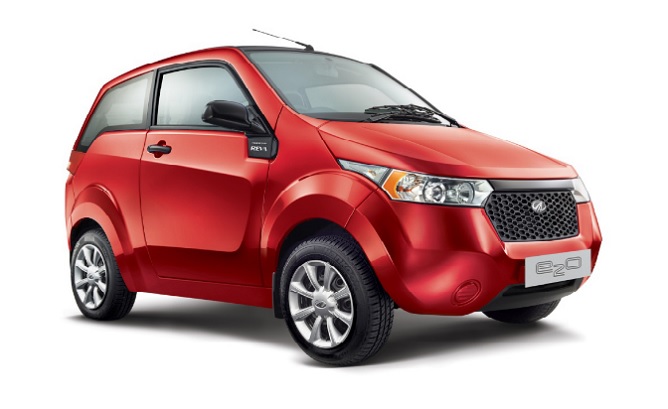 electric vehicle. The companies see it as an opportunity to leverage Ford’s global reach and expertise and Mahindra’s scale in India and its successful operating model. One of the SUVs will be a midsize sport utility vehicle built on the Mahindra platform; it will be sold independently by both companies as separate brands. They’ve also agreed to evaluate co-development of a compact SUV and electric vehicle. They’ll also be working on connected car solutions for consumers. Mahindra has been bringing EVs to the Indian market in recent years, including the e20 through its Reva subsidiary.
electric vehicle. The companies see it as an opportunity to leverage Ford’s global reach and expertise and Mahindra’s scale in India and its successful operating model. One of the SUVs will be a midsize sport utility vehicle built on the Mahindra platform; it will be sold independently by both companies as separate brands. They’ve also agreed to evaluate co-development of a compact SUV and electric vehicle. They’ll also be working on connected car solutions for consumers. Mahindra has been bringing EVs to the Indian market in recent years, including the e20 through its Reva subsidiary.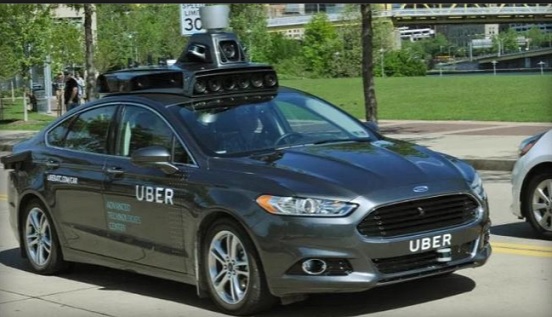 pedestrian fatality in Tempe, Ariz. That fatality involving an Uber test vehicle and driver prompted the ride-hailing firm to suspend its tests in Tempe, Ariz., Pittsburgh, and San Francisco. Toyota has put its fleet of autonomous test vehicles on hold in Ann Arbor, Mich., and in the San Francisco area. Self-driving startup NuTonomy has put its Boston test vehicles on hold after city officials requested it after the Arizona fatal crash. Ford and General Motors are continuing their tests on public roads; Waymo and Lyft declined to comment on the status of their self-driving car test fleets since the fatal Uber collision.
pedestrian fatality in Tempe, Ariz. That fatality involving an Uber test vehicle and driver prompted the ride-hailing firm to suspend its tests in Tempe, Ariz., Pittsburgh, and San Francisco. Toyota has put its fleet of autonomous test vehicles on hold in Ann Arbor, Mich., and in the San Francisco area. Self-driving startup NuTonomy has put its Boston test vehicles on hold after city officials requested it after the Arizona fatal crash. Ford and General Motors are continuing their tests on public roads; Waymo and Lyft declined to comment on the status of their self-driving car test fleets since the fatal Uber collision.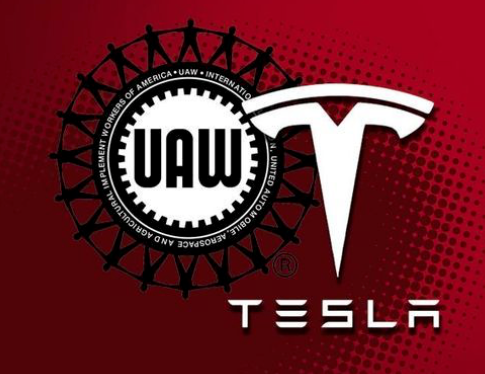 Fremont as Tesla ramps up the Model 3 production line to try and reach goals that had been set last year. The UAW complaints may present another challenge for Tesla management to overcome to reach these targets and retain a stable workforce. The union conflict had been publicized in February 2017 when Tesla employee Jose Moran posted a blog article detailing harsh working conditions. Moran said that some of these workers had contacted the union because of it. In October, Tesla fired about 700 workers, which CEO Elon Musk said was part of routine performance reviews. Volkswagen has faced similar efforts from the UAW to organize its plant in Chattanooga. The union lost a vote in 2014 to unionize factory employees, but has successfully organized a group within the plant to stay with it. Workers in the greater Bay Area, where Fremont is based, have been known to be more supportive of unions than in other parts of the country; but the UAW and all the other major unions in the U.S. have been losing support and membership for several decades. Convincing a majority of the workforce to bring in the union is very difficult to carry out.
Fremont as Tesla ramps up the Model 3 production line to try and reach goals that had been set last year. The UAW complaints may present another challenge for Tesla management to overcome to reach these targets and retain a stable workforce. The union conflict had been publicized in February 2017 when Tesla employee Jose Moran posted a blog article detailing harsh working conditions. Moran said that some of these workers had contacted the union because of it. In October, Tesla fired about 700 workers, which CEO Elon Musk said was part of routine performance reviews. Volkswagen has faced similar efforts from the UAW to organize its plant in Chattanooga. The union lost a vote in 2014 to unionize factory employees, but has successfully organized a group within the plant to stay with it. Workers in the greater Bay Area, where Fremont is based, have been known to be more supportive of unions than in other parts of the country; but the UAW and all the other major unions in the U.S. have been losing support and membership for several decades. Convincing a majority of the workforce to bring in the union is very difficult to carry out. lead the company through a transition over to more profitable trucks and crossovers, electrification, and smart vehicle technologies. Last week, Ford said it will be replacing more than 75% of its North American lineup and adding four nameplates in the next two years. By 2020, the automaker hopes to see pickups, utilities, and vans making up 86% of its sales, up from about 70% today. The automaker will be selling eight utilities in North America, up from six today.
lead the company through a transition over to more profitable trucks and crossovers, electrification, and smart vehicle technologies. Last week, Ford said it will be replacing more than 75% of its North American lineup and adding four nameplates in the next two years. By 2020, the automaker hopes to see pickups, utilities, and vans making up 86% of its sales, up from about 70% today. The automaker will be selling eight utilities in North America, up from six today.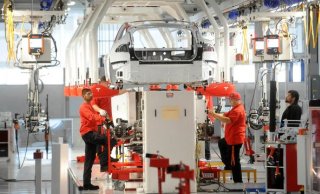 3 production. CNBC reported Wednesday that a current Tesla engineer estimated that 40% of parts made or received at the Fremont factory require rework. Sometimes, the parts need to be shipped back out of the plant for rework, and in other cases, vehicles seem to be pulled off the assembly line for repairs before being shipped out. Questions are being raised out how effective Musk has been managing the company through a difficult conversion to a mass market manufacturer. The electric automaker has been seeing other problems come up, including three of its top financial executives leaving recently. News came out earlier this week that the company stopped production in Fremont to adjust equipment that can increase the production rate. Production was reportedly suspended from February 20 to February 24 to make these changes. Some of the problems have also been traced back the Gigafactory battery plant near Reno, Nev. But most of the problems seem to be coming from the Fremont plant.
3 production. CNBC reported Wednesday that a current Tesla engineer estimated that 40% of parts made or received at the Fremont factory require rework. Sometimes, the parts need to be shipped back out of the plant for rework, and in other cases, vehicles seem to be pulled off the assembly line for repairs before being shipped out. Questions are being raised out how effective Musk has been managing the company through a difficult conversion to a mass market manufacturer. The electric automaker has been seeing other problems come up, including three of its top financial executives leaving recently. News came out earlier this week that the company stopped production in Fremont to adjust equipment that can increase the production rate. Production was reportedly suspended from February 20 to February 24 to make these changes. Some of the problems have also been traced back the Gigafactory battery plant near Reno, Nev. But most of the problems seem to be coming from the Fremont plant. going to soften up on fuel economy and emissions standards, and may be in conflict with what the state of California is planning to do. During an interview with Bloomberg News on Tuesday,
going to soften up on fuel economy and emissions standards, and may be in conflict with what the state of California is planning to do. During an interview with Bloomberg News on Tuesday,  Trucks is taking natural gas and electricity seriously as alternative fuels, but neither will be taking the lead away from diesel anytime soon. Daimler’s Freightliner Trucks subsidiary showed off several natural gas-powered trucks in the exhibit hall. The truck maker’s Fuso division is rolling out the eCanter electric medium-duty truck and the E-Fuso Class 8 electric truck. But for now, diesel is still the most efficient and cost-effective fuel, the Daimler executive said. While natural gas and battery-powered have become the most talked-about alternatives to diesel, their limitations are causing fleets to look more carefully at their options, she said. Charging and alternative fueling stations are very limited in comparison to ample diesel stations across the country. There’s also the question of realistic range for the vehicle. Electric trucks are particularly vulnerable to temperature, cargo loads, and speed traveled on highways in having enough range to carry out the freight hauling goals of fleet operators. Schaefer does see gains being made in new connected vehicle technologies, including active safety systems. She also supports the idea that green goes beyond tailpipe emissions; managers are encouraged to bring sustainability practices into their strategic planning while reducing cost and waste. Other highlights at the Green Truck Summit included XL Hybrids introducing the Ford F-150 XLP plug-in hybrid pickup, which can improve fuel economy by up to 50%. Lightning Systems showed off an electric Fort Transit cargo van that’s adding a hydrogen fuel cell vehicle that can extend range by 200 miles.
Trucks is taking natural gas and electricity seriously as alternative fuels, but neither will be taking the lead away from diesel anytime soon. Daimler’s Freightliner Trucks subsidiary showed off several natural gas-powered trucks in the exhibit hall. The truck maker’s Fuso division is rolling out the eCanter electric medium-duty truck and the E-Fuso Class 8 electric truck. But for now, diesel is still the most efficient and cost-effective fuel, the Daimler executive said. While natural gas and battery-powered have become the most talked-about alternatives to diesel, their limitations are causing fleets to look more carefully at their options, she said. Charging and alternative fueling stations are very limited in comparison to ample diesel stations across the country. There’s also the question of realistic range for the vehicle. Electric trucks are particularly vulnerable to temperature, cargo loads, and speed traveled on highways in having enough range to carry out the freight hauling goals of fleet operators. Schaefer does see gains being made in new connected vehicle technologies, including active safety systems. She also supports the idea that green goes beyond tailpipe emissions; managers are encouraged to bring sustainability practices into their strategic planning while reducing cost and waste. Other highlights at the Green Truck Summit included XL Hybrids introducing the Ford F-150 XLP plug-in hybrid pickup, which can improve fuel economy by up to 50%. Lightning Systems showed off an electric Fort Transit cargo van that’s adding a hydrogen fuel cell vehicle that can extend range by 200 miles. reported selling 23,297 Bolts in the U.S. Barra said that the Lake Orion, Mich., assembly plant can be easily adjusted to build more Bolts. Barra also called for expansion of the $7,500 federal tax credit for electric vehicle purchases. GM vehicles will be seeing that incentive phase out later this year unless the cap is lifted. The automaker’s commitment to zero-emission vehicles – battery electric and hydrogen fuel cell vehicles – will stay in place regardless of changes to federal fuel economy standards, Barra said.
reported selling 23,297 Bolts in the U.S. Barra said that the Lake Orion, Mich., assembly plant can be easily adjusted to build more Bolts. Barra also called for expansion of the $7,500 federal tax credit for electric vehicle purchases. GM vehicles will be seeing that incentive phase out later this year unless the cap is lifted. The automaker’s commitment to zero-emission vehicles – battery electric and hydrogen fuel cell vehicles – will stay in place regardless of changes to federal fuel economy standards, Barra said.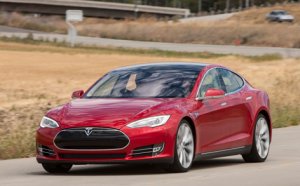 18, has become
18, has become 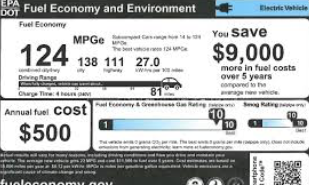 when adopted a few years ago, it may not be that effective in answering questions for car shoppers. The U.S. Environmental Protection Agency doesn’t have plans to make changes to the Motor Vehicle Fuel Economy Label, and no interviewed for the article had a clear vision implementing an improved comparison system for consumers looking at all-electric and plug-in hybrid vehicles.
when adopted a few years ago, it may not be that effective in answering questions for car shoppers. The U.S. Environmental Protection Agency doesn’t have plans to make changes to the Motor Vehicle Fuel Economy Label, and no interviewed for the article had a clear vision implementing an improved comparison system for consumers looking at all-electric and plug-in hybrid vehicles. Leadership Group, which supports seeing continued progress on reducing emissions and oil consumption. Made up of Advanced Engine Systems Institute, the Aluminum Association, the Emission Control Technology Association, Manufacturers of Emission Controls Association, and Motor & Equipment Manufacturers Association, member companies want to have their voices heard as federal agencies prepare to finalize standards for phase two of the fuel economy rules. They’ve been making large investments to bring emissions-reducing technologies to the market and to meet domestic goals, and to make U.S.-built vehicles very competitive on the global stage. By the end of March, the U.S. Environmental Protection Agency is scheduled to announce whether it will keep the fuel economy and emissions standards in place, or begin work to modify them. The Automotive Technology Leadership Group would like to make sure that the National Highway Traffic Safety Administration, the state of California, and other states that follow California’s emissions standards, will have their concerns heard and coordinated within the EPA’s ruling.
Leadership Group, which supports seeing continued progress on reducing emissions and oil consumption. Made up of Advanced Engine Systems Institute, the Aluminum Association, the Emission Control Technology Association, Manufacturers of Emission Controls Association, and Motor & Equipment Manufacturers Association, member companies want to have their voices heard as federal agencies prepare to finalize standards for phase two of the fuel economy rules. They’ve been making large investments to bring emissions-reducing technologies to the market and to meet domestic goals, and to make U.S.-built vehicles very competitive on the global stage. By the end of March, the U.S. Environmental Protection Agency is scheduled to announce whether it will keep the fuel economy and emissions standards in place, or begin work to modify them. The Automotive Technology Leadership Group would like to make sure that the National Highway Traffic Safety Administration, the state of California, and other states that follow California’s emissions standards, will have their concerns heard and coordinated within the EPA’s ruling.